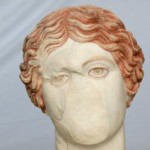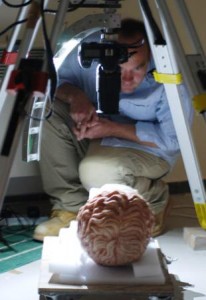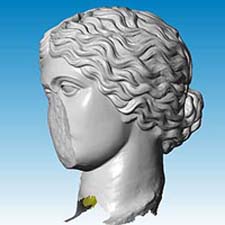It’s hard to imagine a Rome where all the shiny white marble was painted in bright, even garish to our neutral-HGTV eyes, colors, in large part because fragments of color were routinely scraped off of ancient statuary in order to conform with revivalist fashions.
(The most famous instance of this was when the British Museum “restored” the much-disputed Elgin marbles in the late 1930’s by scraping off 1/10th of an inch of the surface, thereby removing all the patina and much of the carving detail.)
 But yet again into the breach steps Vesuvius, whose explosion stopped time even as it slaughtered the inhabitants, thereby preserving the marble head of what appears to be a wounded female warrior in vividly painted condition.
But yet again into the breach steps Vesuvius, whose explosion stopped time even as it slaughtered the inhabitants, thereby preserving the marble head of what appears to be a wounded female warrior in vividly painted condition.
The Roman statue was discovered by the Herculaneum Conservation Project in the ancient ruins of Herculaneum, a town preserved in the same eruption that buried nearby Pompeii in AD 79. It is thought to represent a wounded Amazon warrior, complete with painted hair and eyes preserved by the ash that buried the town.
Scientists at the University of Southampton are using laser scanning and computer modelling technologies made famous by Hollywood in animated movies like WALL-E to fill in the topographical and color blanks.
Dr Williams used state-of-the-art equipment to accurately measure (within 0.05 of a millimetre) every surface of the bust and translated that information into a computer model. Dr Greg Gibbons, also of WMG, then used rapid prototyping to create a physical 3D model of the head revealing the smallest detail.
Further recording was carried out on site by experts in archaeological computing from Southampton, led by Dr Graeme Earl. They used a novel form of photography which provided an extremely detailed record of the texture and colour of the painted surfaces. […]
In the final step Professor Alan Chalmers, head of WMG’s visualisation team and an expert in ultra-realistic graphics, will apply techniques to the computer model to exactly reproduce the lighting and environmental conditions under which the painted statue would have originally been created and displayed. This visualisation will provide archaeologists with an otherwise impossible view of how the original statue may have looked in context, and allow them to experiment with alternative hypotheses.
Here’s the nice lady being scanned, and the first reconstruction rendered from the scan data.


These heads are scary…
What heads? There’s only one mentioned and it’s beautiful, not scary.